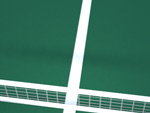Tennis

Forehand
The forehand in tennis and other racket sports such as table tennis, squash and badminton is a shot made by swinging the racket across one's body with the hand moving palm-first. In tennis, except in the context of the phrase forehand volley, the term refers to a type of groundstroke—a stroke in which the ball has bounced before it is struck. It contrasts with the backhand, the other type of groundstroke. For a right-handed player, the forehand is a stroke that begins on the right side of his body, continues across his body as contact is made with the ball, and ends on the left side of his body. It is considered the easiest shot to master, perhaps because it is the most natural stroke. Beginners and advanced players often have better forehands than any other shots and use it as a weapon.
Most forehands are hit with topspin because it helps keep the ball from landing outside the court. On some occasions, such as an approach shot, a player can opt to hit with backspin, which can also be called a 'slice'.
Players with great forehands often build their main strategy around it. They set up a point until they have a good chance of striking a powerful forehand to win the point. A well-known tactic is to run around a ball on their backhand side in order to hit a forehand cross-court, called the inside-out forehand.
Grips
There are four main grips for executing the forehand and their popularity has fluctuated over the years. They are the western, the semi-western, the eastern, and the continental. Some rarer grips include the semi-eastern and extreme-western or Hawaiian.
Western
The western was widely used in the first two decades of the 20th century. For a number of years the small, apparently frail 1920s player Bill Johnston was considered by many to have had the best forehand of all time, a stroke that he hit shoulder-high using a western grip. Few top players used the western grip after the 1920s, as many of them moved to the eastern and continental, but in the latter part of the 20th century, as shot-making techniques and equipment changed radically, the western forehand made a strong comeback and is now used by many modern players. Some consider it to be an extreme or radical grip, however. The maximum amount of topspin can be generated with this grip.
Extreme-Western, "Hawaiian"
The extreme-western or Hawaiian grip is a very extreme tennis grip where the player places their knuckle past the 5th bevel on the tennis racket. It's considered by some to be too extreme for tennis, as the optimal strike zone for this grip is very high up and is suitable only for pure spin hitting. Indeed; flattening out a shot at that height is near impossible due to wrist constrictions, and so this grip is suited only for clay court specialists. However, some players are able to take advantage of this grip's massive spin generation due to their defensive play style or height, which allow them to hit the strike zone often. An example would be Florian Mayer. The Extreme-Western is also known for causing arm and wrist problems if employed incorrectly.
Semi-Western
The semi-western grip is also widely used today, and falls in between the western and the eastern. It is popular with players who want to hit a fair amount of topspin, but still want to be able to flatten out the ball for finishing shots. It is currently the most popular forehand grip among ATP and WTA pros, with many top players employing this grip on their forehand. It can be further modified to be closer to a semi-eastern grip, or more extreme to a full-western grip depending on the player's profile and playing style. Many of the world's current players use this grip, such as Rafael Nadal, Novak Djokovic, Andy Murray, David Ferrer, Jo-Wilfried Tsonga, Victoria Azarenka,and countless other professional tennis players in today's modern game.
Semi-Eastern
A rare grip used in modern tennis, it is a hybrid between the eastern and semi-western forehand grips. Its main purpose is a modification over the traditional eastern grip to help develop more spin on the forehand, and thus gives a player more control and options over their shot than a conventional eastern grip. It's a very versatile grip, allowing multiple ways of hitting the ball, such as the double bend arm or the straight arm, and can be further modified with the wrist and forearm movement for added spin and power. It also can be used to flatten out the ball for a finishing shot or roll over the ball for a more consistent topspin shot without having to change grips. It does however, take a bit longer to master than other forehand grips due to its unique nature and more traditional style, but will present more options when faced with any type of shot.
Eastern
The eastern grip widely replaced the western in the 1920s and thereafter was used by such World No. 1 players as Ellsworth Vines, Don Budge, and Jack Kramer, all of whom were considered to have very powerful forehands. Many beginners start with the eastern grip because of its comfortable feel. It is often described as shaking hands with the racquet. Forehands hit with the eastern can have either topspin or backspin, as the gripping hand is on the same plane as the racquet, and can thus be tilted up for topspin or down for backspin rather easily. Although rarer on the professional tour as it makes hitting topspin somewhat difficult, there are some notable players who use the eastern grip to great effect. Juan Martín del Potro is an excellent example of an eastern forehand user. Roger Federer is often noted as having an eastern grip, although his forehand lies somewhere in between semi-western and eastern. [1] This twist on the forehand grip is commonly attributed to his power and versatility over the forehand side.
Continental
The continental grip was popular with many Europeans of the 1920s and 1930s and with many Australians of the 1940s and 1950s. The continental has the advantage of being used for all strokes: serves, volleys, forehands, and backhands, without having to be shifted in the player's hand, as is the case with all the other grips. It is particularly well-suited for hitting low balls — "taking the ball on the rise" — but is generally considered inferior for most forehands. It is extremely rare for a professional player to utilize a "continental" grip, due to the difficult topspin generation and poor ability to hit balls above the strike zone, crucial in today's heavy topspin game. Richard Gasquet is an example of a player who uses the "continental" forehand, but he generally switches his grip over to a semi-western during his takeback process. Fred Perry, the great English player of the 1930s and 1940s was notable for his snap forehand using the continental grip and taking the ball on the rise.
Two-handed forehand
No matter which grip is used, most forehands are generally executed with one hand holding the racquet, but there have been fine players with two-handed forehands. In the 1940s and 50s the Ecuadorian/American player Pancho Segura used a two-handed forehand with devastating effect against larger, more powerful players. His frequent adversary and even greater player Jack Kramer has called it the single finest shot in the history of tennis. Some players will use a two-handed forehand when they need a sure-fire in. The constricted movement will generally generate less power, but more racket head control.
Evolution
The classical forehand where a player hit through the ball and finished his follow-through above his shoulder was the dominant forehand usage for most of tennis history. Players as recent as Pete Sampras and Andre Agassi used the classical forehand. With recent tennis racquet technology improvements, generating power has increasingly become easier and hence having more control has become an emphasis for current professional tennis players. This has resulted in the pro players now using a windshield wiper forehand where the follow-through ends up with the racquet ending across the body rather than over the shoulder. This enables more top spin to be imparted to the ball, thus controlling the extra power generated while still keeping the ball in court. Most pro players now use the windshield wiper forehand, with Rafael Nadal, Roger Federer and Novak Djokovic among other pro tennis players all employing the windshield wiper forehand.
SPORTS

RESOURCES
This article uses material from the Wikipedia articles "Tennis" and "Forehand", which is released under the Creative Commons Attribution-Share-Alike License 3.0.
© Stories Preschool. All Rights Reserved.









